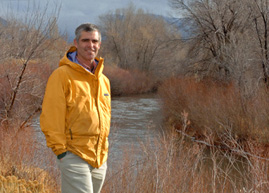ISU professor studies relationship between Pacific salmon, Nez Perce culture
December 15, 2006

Pacific salmon and steelhead are “keystone” ecological wildlife species to the Pacific Northwest, where, according to the Washington Department of Natural Resources, more than 130 wildlife species depend on Pacific salmon for part of their diet. And that doesn’t count all the plants and microorganisms that depend on nutrients the return of salmon to waterways provides.
Pacific salmon can be considered a keystone species in other ways, such as how vital they are to the regional economy of Northwest commercial salmon fishing or to the local economy of a town like Riggins, Idaho, where sportfishing brings in tourists’ dollars.
Idaho State University assistant professor of anthropology Dr. Benedict Colombi studies a third facet of how the salmon are a keystone species, in terms of the cultural impact the salmon have on various groups. His studies thus far have primarily focused on Idaho’s Nez Perce Tribe and other indigenous groups in the Northwest, but he plans to expand his studies on much wider global scale to the world’s polar regions.
This fall, Colombi received a $3,500 grant award from the Idaho Humanities Council to carry out a research project titled “The Nez Perce Tribe and the Extinction of Pacific Salmon in Region Six: A Social Power Approach.” This topic is related to his doctoral dissertation, “The Nez Perce Tribe vs. Elite-Directed Development in the Lower Snake river Basin: The Struggle to Breach the Dams and Save the Salmon,” which he defended last January and was awarded a doctoral degree by Washington State University in Pullman, Wash., last May.
Colombi will use the IHC grant to develop a book project with the University of Nebraska Press. The title of the book is the same title of the grant. He hopes to complete a draft of the book by August 2008.
The ISU professor contends that the extinction of wild Pacific salmon is a threat to the Nez Perce culture, something resource managers should consider when making decisions. Managing salmon in the Pacific Northwest is a complex endeavor, bringing up a wide range of political, economic, legal and social issues. Cultural issues of salmon management shouldn’t be overlooked, Colombi said.
“The culture of the Nez Perce is tied to the return of Pacific salmon to waterways of Idaho on the Snake, Clearwater and Salmon river systems,” Colombi said. “Nez Perce tribal members have told me that when the salmon go, so will the Nez Perce culture, because so much of the culture is built around the return of salmon. Salmon have to be saved to perpetuate the culture. The loss of native Pacific salmon runs impacts everything from the Nez Perce language to how Nez Perce youth view their own culture.”
In his doctoral thesis, Colombi outlined a theory of “a social power approach” that discussed how “elite socio-economic groups” concentrate social power and the use of resources and socialize the costs, and this can generate negative social, economic and environmental costs. The four dams on the lower Snake River, the three private dams on the middle Snake River, and Dworshak Dam on the North Fork of the Clearwater River benefit some irrigators, shippers, and generate power, but negative impacts include the extinction of wild salmon and steelhead, and the effects of that on the environment and cultures of the Pacific Northwest.
“My research isn’t just on contemporary issues, but looks at the relationship between salmon and the Nez Perce in Idaho for the last 11,000 years,” Colombi said. “The return of salmon is key to the Nez Perce culture. The Nez Perce individually or collectively never agreed to the dams from the beginning.”
Colombi said he is in favor of breaching the four dams on the lower Snake River to increase the number of salmon and steelhead returning to Idaho, although he sees a lack of political will in the region to accomplish this.
“In a perfect world the dams would be breached, allowing more salmon to return, and provide more water for crops in places like eastern Idaho, where water must be released from the upper Snake River dams to flush smolts downstream,” Colombi said.
He said hatchery fish are not an adequate replacement for wild runs of salmon.
“Any biologist will tell you that hatchery fish are not self-sustaining. They’re not reproducing in rivers, and sustaining them becomes a capital and human-labor intensive endeavor,” added Colombi.
As noted above, the ISU professor plans to extend his studies of the relationship between Pacific salmon and indigenous people well beyond the United State’s Pacific Northwest Region. He is pursuing a National Science Foundation Grant to complete a cooperative study to investigate the “globalization of indigenous peoples and salmon in the polar regions of the world, combining field sites in Russia, China, Norway, Tasmania, Chile and the United States.
“The globalization of the fishing industry has had a dramatic impact on indigenous peoples’ lives and their cultures,” Colombi said. “We want to have a greater understanding of that impact, both negative and positive.”
Categories:
